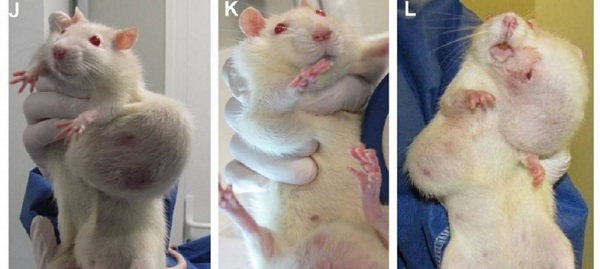
In a report from Natural Society, former Monsanto employee, Richard Goodman, has been removed from his position on the Editorial Board of the Journal of Food and Chemical Toxicology. He had been appointed Associate Editor shortly before the journal retracted the Seralini study.
A. Wallace Hayes, former Editor-in-Chief, will be replaced as well.
Prof Gilles-Eric Seralini’s study showed that GMO food causes tumors in rats. It was reported far and wide, even in the mainstream media.
According to Natural Society’s report, an “unbiased” Editor-in-Chief will be replacing Hayes, who had retracted the paper written by the Seralini team. The paper proved the toxicity of GMO’s “beyond any shadow of a doubt.”
The study was done in response to a 2004 study declaring Monsanto’s NK603 GMO maize safe:
“…a predominantly French team led by Prof Gilles-Eric Séralini undertook a two-year (over 700 days), feeding trial [2], which was otherwise similar. Their work was published in September 2012, also inFCT. The early warnings that had been dismissed in the Monsanto paper developed into serious illnesses, including damage to liver, kidneys, pituitary gland and, most notably, early deaths and development of large tumors in females. In addition, the study included trials of minute amounts of Monsanto’s Roundup, the herbicide to which tolerance has been genetically engineered into NK603, in the rats’ drinking water.”
It was some time later that the Seralini study was removed from the Journal of Food and Chemical Toxicology, and according to the reporter, “this fact has been used in a foolhardy way by biotech shills to promote the ‘fallacy’ of biotech dangers on more blogs and Facebook posting than I’d like to count.”
Apparently quite a few scientists contacted the Journal after the Seralini study was retracted to find out why. Many of the scientists seemed to think the Journal was giving in to pressure from the biotech industry, and many in the academic world were outraged as well.
The new Editor-in-Chief, Jose Domingo, has published papers showing that the safety of GM crops is not an established fact.
“Critical changes have this year been made at the journal, Food and Chemical Toxicology, from which the Editor-in-Chief A. Wallace Hayes retracted the important paper by the Seralini team. The Editorial Board of the journal [19] now has a new Editor-in-Chief, José L. Domingo, who has published papers showing that safety of GM crops is not an established fact; and the Editorial Board no longer includes Richard Goodman, the ex-Monsanto employee who became Associate Editor for Biotechnology not long before the Seralini paper was retracted.”
Those at Natural Society say the Seralini study found an audience even with its retraction from the Journal, and they provide links for further studies here.
Sources:
Meyer, Nick. March Against Monsanto. Mar 30, 2015. (http://www.march-against-monsanto.com/ex-monsanto-employee-removed-from-medical-journal-that-retracted-study-showing-gmos-cause-tumors/)
Novotny, Eva (2015). Scientific Publicaton in Peril: the Seralini Affair. Scientists for Global Responsibility. Retrieved from http://www.sgr.org.uk/resources/scientific-publication-peril-seralini-affair
Sarich, Christina. Natural Society. Mar 30, 2015. (http://naturalsociety.com/huge-win-former-monsanto-employee-is-fired-from-major-scientific-journals-editor-position/)
You want to discuss a certain topic with likeminded people or you want to organize a local protest or you have an idea for a project that can help people in need in your local community or all around the world? Join our forum! www.anonboards.com
You want to support Anonymous Independent & Investigative News? Please, follow us on Twitter: Follow @AnonymousNewsHQ






Again with the rats that grow tumors? Wasn’t it shown that the strain of rats used in the study grow tumors as a result of the genetic lineage of their strain? That it doesn’t matter what they eat they were going to grow tumors anyway?
Besides, this article says that Seralini’s paper proved the toxicity of GMOs beyond a show of a doubt. So, are we talking all GMOs no matter what the genetic modification is? If you genetically modify a crop food it’s going to give you tumors? Doesn’t matter what you did in genetically modifying it, you touched the DNA. That’s it. You eat it, you get tumors. End of story. Or are we JUST talking about the NK603 maize that was used in the test? Can we reasonably expect both NK603 corn and golden rice and arctic apples to give you tumors when their genetic modifications are completely different and produce completely different proteins with completely different modes of action and metabolic pathways?
On top of that, if they proved beyond a shadow of a doubt that GMOs are toxic, then they have established molecular target sites by which toxicity is induced, yes? Have they established an LD50 (lethal dose 50% of test population) for the consumption of NK603 corn? How about an RD50? At what dose does NK603 corn induce toxic effects, did they establish that? What about metabolic pathways? Did this study delineate any metabolic detoxification pathways this corn would go through once it gets to the liver (after, of course, being chewed up, digested by stomach acid, and absorbed by the small intestine)? What metabolites result from the interaction with cytochrome P450 monooxygenases? Did the study cover that? What are the toxicokinetics and toxicodynamics of NK603 corn?
No. In all cases, no. No answer or satisfactory evidence was given. It does not seem that critical thinking was applied to evaluating the evidence of this study by those who are getting behind these results, or by those who wrote the paper. It did not prove beyond a shadow of a doubt the toxicity of GMOs, not by any stretch of the imagination except the imaginations of those who are biased against this technology. It didn’t even answer some very basic toxicology questions.
The one thing the Seralini paper did illustrate is the need for the peer review process to be subjected to public scrutiny and criticism so that peer reviewers get their crap together and do not allow junk science to be published in the first place. Science has a certain seal of authority and validity to it because of the peer review process and because the scientific community scrutinizes itself. Issues like this paper and the Andrew Wakefield paper damage that reputation.
(By the way, I’m NOT paid by anyone to have the point of view that I do, I’m a graduate student and I should be studying and doing research right now, not wasting time ranting online.)
kurt i would love to see the research that proves absolute non toxicity via all the procedures and pathways you ascribe.
Kurt, Here is a good talk by a molecular biologist about the danger of GMO’s. Try to debunk him and the dozen or so scientific studies he cites.
https://youtu.be/1U-gRNp4Rz4. Good luck in school. I hope you can do something to enrich humanity when you graduate instead of working as a corporate stooge, promoting corporate profits and “tobacco science”.